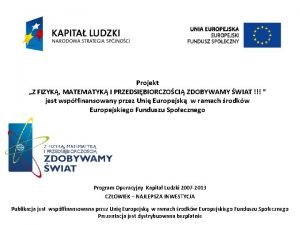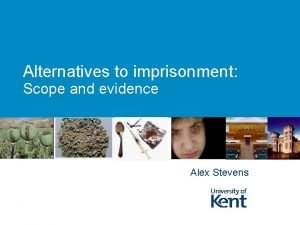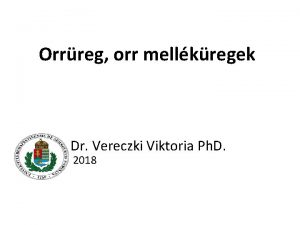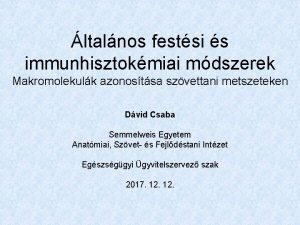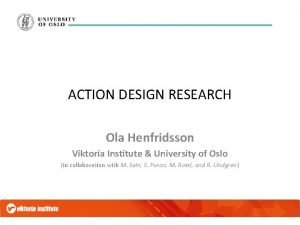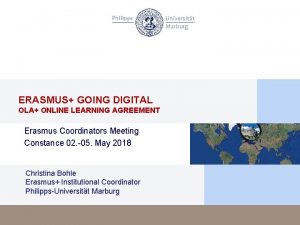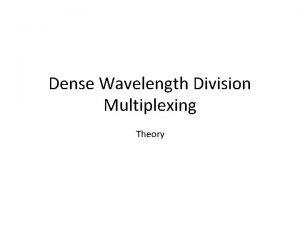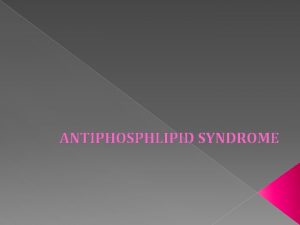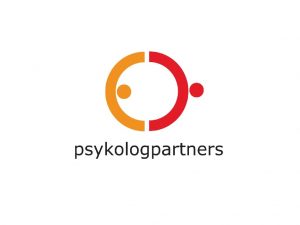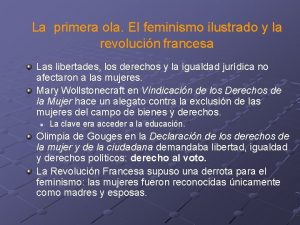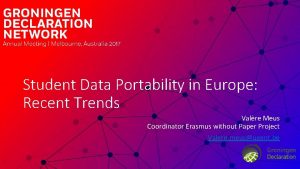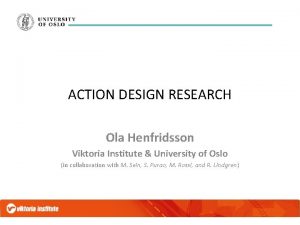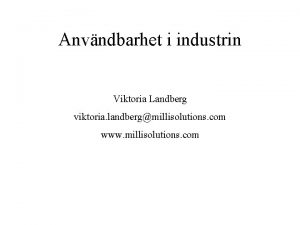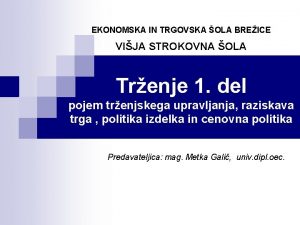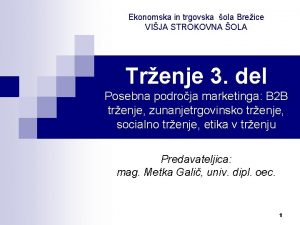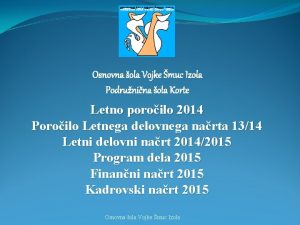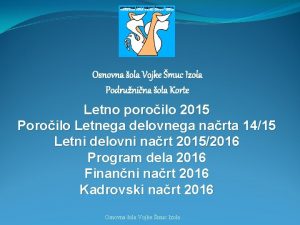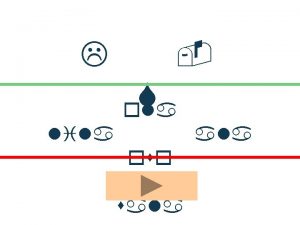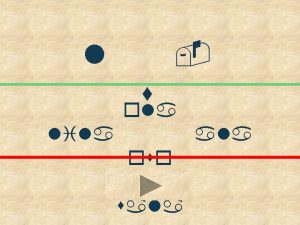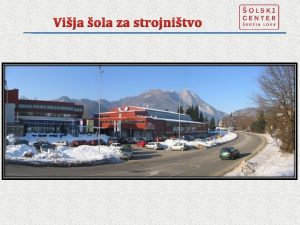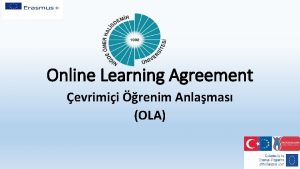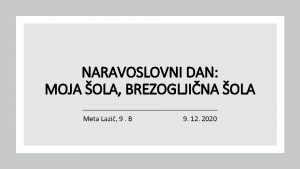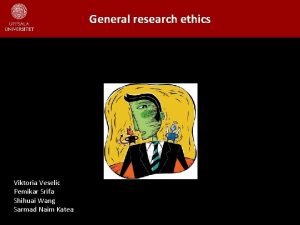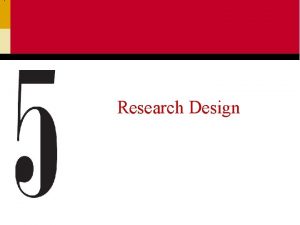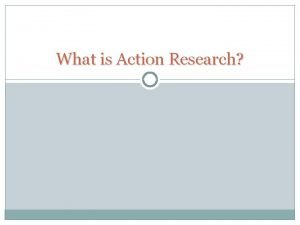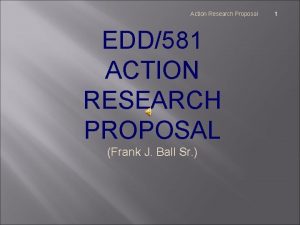ACTION DESIGN RESEARCH Ola Henfridsson Viktoria Institute University
































- Slides: 32

ACTION DESIGN RESEARCH Ola Henfridsson Viktoria Institute & University of Oslo (in collaboration with M. Sein, S. Purao, M. Rossi, and R. Lindgren)

What kind of research is this? – – – – Objective: to improve some kind of organizational capability 1+ year process study Develops a new perspective on this organizational capability Draws on contemporary theory Design and release of multiple versions of a technology Developing innovative features of a technology Eventually causing a change in organizational strategy Developing design principles for a particular type of information system

Available approaches Design Research Action Research

Candidate 1: Design Research • Fundamentally, develop prescriptive design knowledge through building and evaluating IT artifacts intended to solve an identified class of problems – Technical novelty – Must be abstracted to develop knowledge • Relevance of technology artifacts evaluated by utility • DR separates evaluation from building, rarely accomplishing it in authentic settings • The problem of separation and sequencing

Candidate 2: Action Research • Fundamentally, a study of change – Central assumption: complex social processes are best studied by introducing change into these processes and observing their effects • Focus on practical problems with theoretical relevance • Produces results relevant to the organization while simultaneously informing theory • Sees the technology artifact as a black box • No clear emphasis on the technology artifact

What is an IT artifact? • An Ensemble: – The material and organizational features that are socially recognized as bundles of hardware and/or software (cf. Orlikowski and Iacono 2001) • ”technology as structure”: – Structures of the organizational domain are inscribed into the artifact during its development and use

What is an IT artifact? (2) • An emergent thing: – Neither fixed nor independent, instead, emerges from ongoing social and economic practices (Orlikowski and Iacono 2001) • Where does emergence come from? – Interaction between technology and an organizational context (Truex et al. 1999) – Shaped by the interests, values, and assumptions of a wide variety of communities of developers, investors, users, etc. (Orlikowski and Iacono 2001)

What is an IT artifact? (3) • Many artifacts are only partly the work of the designer. – Numerous local actions (e. g. , use, interpretation, negotiation, and redesign) • Cannot be anticipated by reference to any a priori design (Iivari 2003)

Considering the candidates • DR and AR offer incomplete solutions for us – DR supports abstraction and innovation but relegates authentic intervention as secondary – AR supports intervention and knowledge emergence in authentic settings but innovation and abstraction are secondary goals

Our thesis • To study ensemble artifacts, we need a research method that can account for – Both technological and organizational contexts – Shaping of the artifact via design and use – Influences of designers and users

Combining. . . • AR and DR: – Are similar (Järvinen 2007; Lee 2007; Figueiredo and Cunha 2007) – Should be kept apart (Iivari 2007) – Have commonalities (Cole et al. 2005) • Suggestions for combining – Use the two in sequence (Iivari 2007) – Interleave the processes (Lee 2007) – Map commonalities (Cole et al. 2005)

Sequencing Start a DRStart process a DR: process: Identifying a need Building Evaluating Reflecting Start process: Start anan ARAR process : Theorizing

Interleaving Start an AR process: Diagnosing a problem Action planning Action taking Start a DR process : Evaluating, reflecting Specifying learning Build

A New DR Method: ADR • Provides explicit guidance for accomodating building, intervention, and evaluation in a concerted research effort • An approach to produce knowledge by – intervening in an organization – through developing an innovative IT ensemble artifact • Knowledge that – adds to, refines, or generates theory or theories – supports IS practitioners in solving immediate problems

ADR

Stage 1: Problem formulation • An immediate or anticipated problem: – perceived by organizational participants, and framed by the researcher • Identify the class of which the specific problem is an instance • Formulate initial research questions • Identify contributing theoretical bases • Identify prior technology advances

Stage 1: Problem formulation (2) • Practice-inspired Research – Field problems as knowledgecreation opportunities (rather than theoretical puzzles) • Theory-ingrained artifact – Artifacts as carriers of theoretical traces – Iterations based on influences from theory

Stage 2: Building, Intervention, and Evaluation (BIE) • BIE intends to support an iterative process at the intersection of the IT artifact and the organizational environment • Building, intervention, and evaluation are interwoven • Two forms of BIE: – IT-dominant BIE – Organization-dominant BIE

IT-Dominant BIE

Organization-Dominant BIE

Forms of BIE 1. IT-Dominant BIE 2. Organization-Dominant BIE

Stage 2: BIE Principles • Reciprocal shaping – Emphasizes the inseparable influences from two domains: the IT artifact and the organizational context • Mutually influential roles – Mutual learning among participants in an ADR project • Authentic and concurrent evaluation – Formative evaluation

Stage 3: Reflection and Learning • Analyze intervention results • Articulate learning in terms of theories selected • Ongoing evaluation of adherence to principles

Stage 3 principle: Guided Emergence • Captures seemingly incongruent perspectives • Initial design by researchers, shaped by ongoing organizational use and reflected in redesign (Garud et al 2008; Iivari 2003) • Combination of – preliminary design of the artifact (Principle 2) – refined by ongoing interactions among perspectives and participants (Principles 3 and 4 respectively) – outcomes of formative evaluation (Principle 5)

4. Formalization of Learning • Abstract results to a class of field problems • Focused on transferability of results and communication of outcomes • Outcomes specified as design principles and contributions to theory

Stage 4: Principle • Generalized Outcomes: – Generalizing the problem instance – Generalizing the solution instance – Deriving design principles from the design research outcomes • BIE is an inductive step that connects design principles to a class of solutions and a class of problems

ADR

Comparing DR, AR, and ADR

Our contribution • ADR: a customization of Design Research that – – Overcomes Stage-Gate Models for Design Research Recognizes the inherently ensemble nature of IT artifacts Captures innovativeness for both IT and org-dominant versions Reconciles one-case Utility against abstraction to Design Principles • As it – Brings together technology and behavioral IS researchers – Ensures relevance to build bridges with practice

What kind of research is this? – – – – Objective: to improve some kind of organizational capability 1+ year process study Develops a new perspective on this organizational capability Draws on contemporary theory Design and release of multiple versions of the technology Developing innovative features of the technology Eventually causing a change in organizational strategy Developing design principles for a particular type of information system

Many thanks for your attention!

 Suma wieku ani i oli wynosi 22 lata
Suma wieku ani i oli wynosi 22 lata Viktoria ingman
Viktoria ingman Viktoria kerschl
Viktoria kerschl Infundibulum septum
Infundibulum septum Dr. doma viktória
Dr. doma viktória Research action design
Research action design Types of action research
Types of action research Method procedure example
Method procedure example Appendix in quantitative research
Appendix in quantitative research Quantitative qualitative
Quantitative qualitative Exploratory and descriptive research design slideshare
Exploratory and descriptive research design slideshare Purpose of qualitative research
Purpose of qualitative research Ola assessment
Ola assessment Ola 1957 section 2
Ola 1957 section 2 Performance matters dadeschools
Performance matters dadeschools Ola example
Ola example Tania wolfgramm
Tania wolfgramm Suzanne pinel la neige tombe sur mon nez
Suzanne pinel la neige tombe sur mon nez Learning-agreement.eu
Learning-agreement.eu Osc dwdm
Osc dwdm Antiphosphlipid
Antiphosphlipid Dba
Dba Antylopa adaks
Antylopa adaks Ola uzbierała na wakacyjny wyjazd 65 zł
Ola uzbierała na wakacyjny wyjazd 65 zł Ana cuidado con esa ola
Ana cuidado con esa ola Kbt relationsproblem
Kbt relationsproblem Ola lodge
Ola lodge Ola template
Ola template Sesentayochista
Sesentayochista Panija
Panija Backup integrity check
Backup integrity check Ola przegląda się w lustrze. widzi obraz
Ola przegląda się w lustrze. widzi obraz Ola study cycle
Ola study cycle
